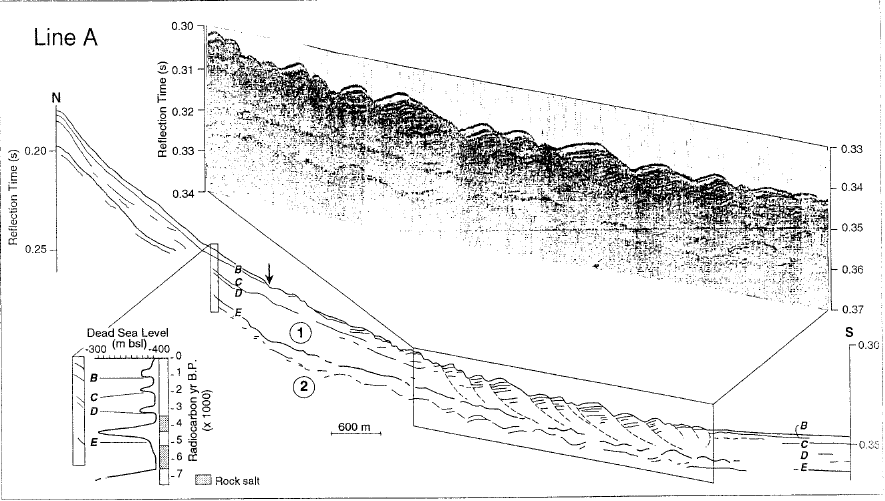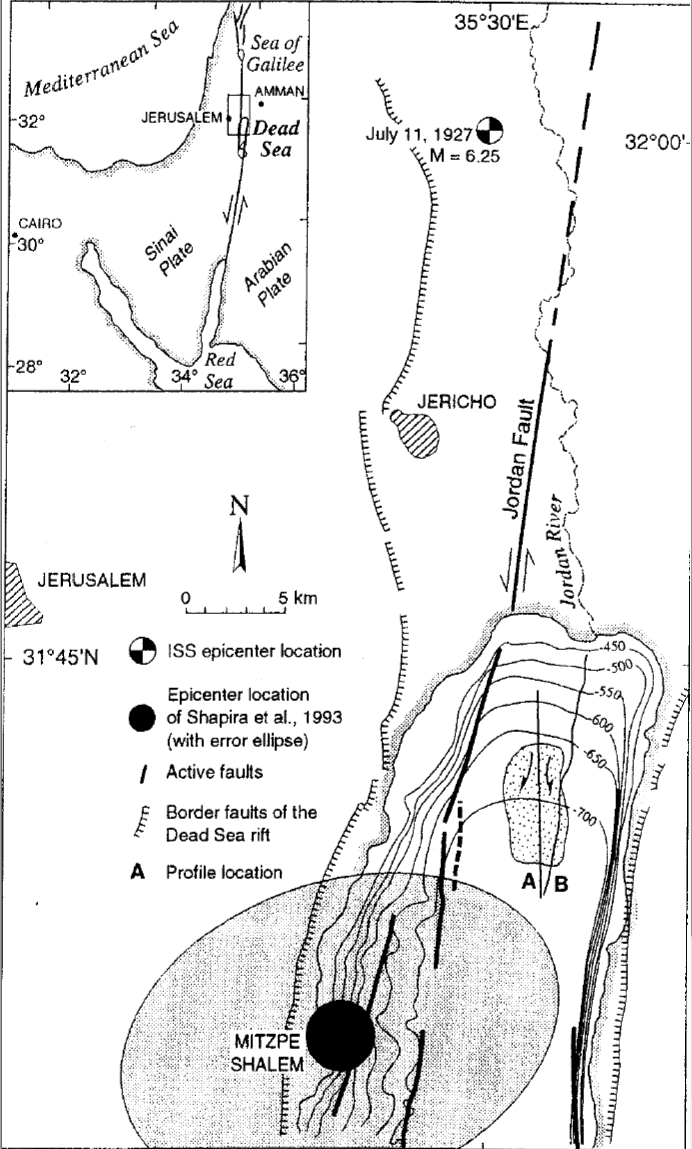Jordan River Delta Slumps
 Figure 2
Figure 2North-south 3.5 kHz seismic-reflection profile A showing cross-sectional detail of submarine slump and correlation of seismic reflectors (B-E; with major, radiocarbon-dated lowstands of Dead Sea (Frumkin et al., 1991); m bsl is metres below sea level. Arrow indicates headwall scarp of slump. Two seismically triggered slump events are labeled 1 and 2 (see text for description).
Niemi and Ben-Avraham (1994)
Maps, Aerial Views, and Sections
Map
Normal Size
 Figure 1
Figure 1Mapped faults and slump In northern Dead Sea. Location of active faults that deform subbottom strata in north basin of Dead Sea are based on analyses of 3.5 kHz and Sparker high-resolution seismic-reflection data (Neev and Hall, 1976). Seismic-reflection profiles A and B across submarine slump (stippled area) are shown in Figures 2 and 3, respectively. Map also shows International Seismological Summary (ISS) catalogue epicenter of July 11, 1927, Jericho earthquake, although location of epicenter beneath Dead Sea fits seismological data better (Shapira et al., 1993). Contours are in metres below sea level.
Niemi and Ben-Avraham (1994)
Magnified
 Figure 1
Figure 1Mapped faults and slump In northern Dead Sea. Location of active faults that deform subbottom strata in north basin of Dead Sea are based on analyses of 3.5 kHz and Sparker high-resolution seismic-reflection data (Neev and Hall, 1976). Seismic-reflection profiles A and B across submarine slump (stippled area) are shown in Figures 2 and 3, respectively. Map also shows International Seismological Summary (ISS) catalogue epicenter of July 11, 1927, Jericho earthquake, although location of epicenter beneath Dead Sea fits seismological data better (Shapira et al., 1993). Contours are in metres below sea level.
Niemi and Ben-Avraham (1994)
Aerial Views
Sections
| Image | Description | Source |
|---|---|---|

 Figure 2
Figure 2North-south 3.5 kHz seismic-reflection profile A showing cross-sectional detail of submarine slump and correlation of seismic reflectors (B-E; with major, radiocarbon-dated lowstands of Dead Sea (Frumkin et al., 1991); m bsl is metres below sea level. Arrow indicates headwall scarp of slump. Two seismically triggered slump events are labeled 1 and 2 (see text for description). Niemi and Ben-Avraham (1994) |
Fig. 2 - Line A | Niemi and Ben-Avraham (1994) |

 Figure 3
Figure 3Sparker profile B of Jordan River delta. Triangle marks base of delta wedge. Line drawing shows our interpretation of vertically stacked slumped sediments. Upper four slumps have better definition with shallow failure planes and chaotic reflectors separated by undisturbed parallel reflectors. Location of these slump deposits beneath 1927 slump suggests that they formed by similar slip on adjacent fault segment and represent succession of older seismic-triggering events. Reches and Hoexter (1981) |
Fig. 3 - Line B | Niemi and Ben-Avraham (1994) |
Master Seismic Events Table
Notes about the Survey and the interpretation of the data
To study active tectonic processes in the Dead Sea, >1250 km of 3.5 kHz high-resolution seismic-reflection data were collected with a 1 km grid spacing in the north basin. From analyses of the 3.5 kHz and Sparker single-channel seismic-reflection data (Neev and Hall, 1976, 1979), we mapped active faults flanking the margins of the deep north basin of the Dead Sea (Fig. 1). Adjacent to a segment boundary of the main fault, we discovered a large submarine slump characterized by backward rotational blocks covering an area 6.15 by 2.75 km (Fig. 1) and having a basal glide plane at ~10 m depth (Fig. 2). The toe of the slump is not very well developed. The headwall scarp is located in the stable bottomset region of the Jordan River delta on a slope of less than 1° in ~250 m water depth ~5.5 km south of the mouth of the river (Fig. 1).
Given the Dead Sea sediment characteristics and that gravity-induced sliding on slopes of less than 3° occurs only where silt and clay are overpressured and underconsolidated (Crans et al., 1980), we conclude that this large submarine slump was triggered by an earthquake. The Dead Sea bottom sediments consist of chemical precipitates (aragonite, calcite, and gypsum) and detrital mud interbedded with layers of rock salt (Elazari-Volcani, 1943; Neev and Emery, 1967; Garber, 1980; Levy, 1984, 1988) that are continuous across the deep basin (Ben-Avraham et al., 1993). Geotechnical measurements on short cores from the Jordan River delta show that the sediments are consolidated and have a high effective angle of internal friction (Almagor, 1990). The predominance of chemical precipitates also leads to a low sediment porosity (Stiller et al., 1983). These characteristics show that Dead Sea sediments are extremely stable in the bottomset slopes of the Jordan River delta and that slump was produced by ground shaking caused by a large earthquake.
